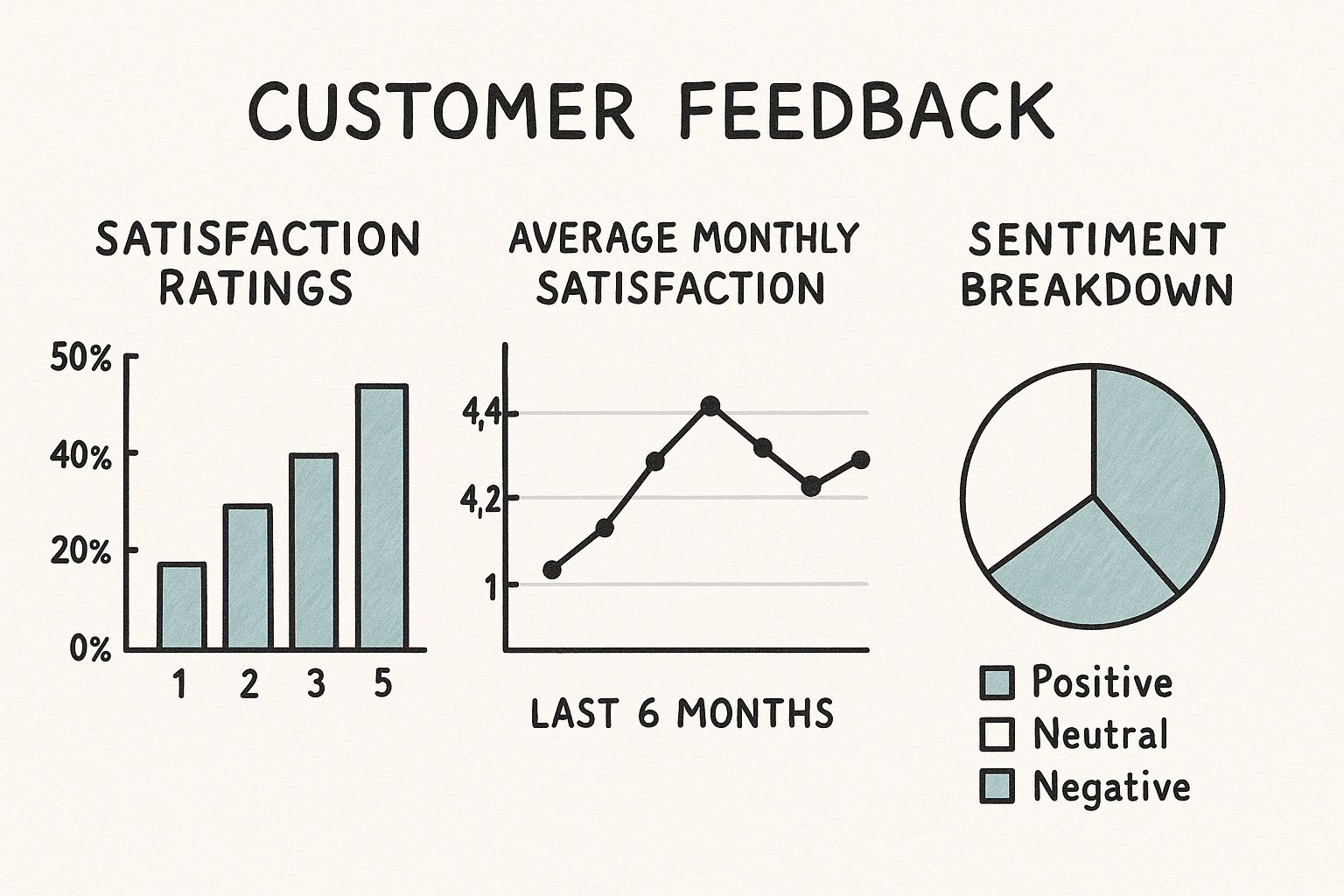
Customer Satisfaction Measurement Tips for Better Results
Understanding Modern Customer Satisfaction Measurement

Leading companies today are changing how they measure customer satisfaction. They realize that a simple "Are you happy?" survey isn't enough to understand long-term loyalty. They are looking beyond surface-level happiness and delving into the factors that truly influence customer behavior. This means understanding the difference between gauging current satisfaction and predicting future customer actions.
The Evolution of Customer Satisfaction Measurement
Traditional methods, like basic surveys, often fail to provide the necessary depth of insight. For instance, relying only on a Customer Satisfaction Score (CSAT) might indicate general customer contentment, but it won't reveal the reasons behind it. These traditional methods don't always capture the full picture of customer sentiment. This is where modern customer satisfaction measurement comes in, offering a more nuanced view of customer feelings and actions. You can learn more about customer satisfaction.
Customer satisfaction measurement has changed significantly, especially as we look towards 2025. According to the Qualtrics XM Institute, consumer satisfaction has remained fairly steady. However, important loyalty metrics, such as trust, advocacy, and repurchase intent, are falling behind. This suggests that while customers might be generally satisfied, they aren't as committed to brands as they once were. The Institute’s global study surveyed nearly 24,000 respondents across 20 industries, providing a comprehensive overview of changing customer loyalty. You can find more details in the Qualtrics Global Satisfaction and Loyalty Study. This lag in loyalty emphasizes the need for businesses to focus on building trust and promoting advocacy to retain customers. It's about cultivating genuine customer relationships.
From Reactive to Proactive Measurement
Modern customer satisfaction measurement is less about reacting to problems and more about proactively seeking opportunities. Instead of waiting for negative experiences to occur, businesses now use data to anticipate customer needs and prevent issues. This proactive approach strengthens customer relationships and fosters loyalty. It's similar to preventative healthcare – getting regular checkups instead of waiting until you’re sick. This proactive stance is essential for businesses to stay competitive.
Key Components of Modern Measurement
- Understanding the Customer Journey: It’s crucial to map the entire customer journey and identify touchpoints where satisfaction can be effectively measured.
- Utilizing Diverse Data Sources: Companies are now integrating data from multiple sources beyond surveys, including social media, online reviews, and customer support interactions.
- Focusing on Actionable Insights: The focus is shifting from mere data collection to extracting actionable insights that drive tangible business improvements.
By embracing these modern approaches, businesses can transform customer satisfaction measurement into a powerful tool for growth. It allows companies to create experiences that not only meet but exceed expectations, turning satisfied customers into loyal brand advocates.
Beyond Basic Surveys: Advanced Measurement Approaches

Traditional metrics like Net Promoter Score (NPS) and Customer Satisfaction Score (CSAT) offer a glimpse into customer sentiment. However, they sometimes lack the depth needed to understand the reasons behind customer behavior. This is especially apparent in today's multi-channel world. For example, a low CSAT score may signal a problem, but it doesn't reveal the specific cause.
This means businesses need more sophisticated methods to measure and improve customer satisfaction. Traditional approaches relied heavily on metrics like NPS and CSAT. But as customer interactions become more fragmented, these metrics can feel less insightful.
As a result, businesses are incorporating AI-powered sentiment analysis, omnichannel feedback collection, and relevant business data. This shift allows companies to move beyond static reports and towards proactive improvements. For a deeper dive into the evolution of customer satisfaction measurement, find more detailed statistics here.
Leveraging AI-Powered Sentiment Analysis
One advanced approach is AI-powered sentiment analysis. This technology goes beyond what customers say and focuses on how they say it. AI can analyze text and voice data to identify underlying emotions and opinions.
This reveals hidden patterns in customer feedback, allowing businesses to understand the nuances of customer sentiment. Sentiment analysis can be applied to large amounts of unstructured data from sources like social media, online reviews, and support tickets. This provides a broad view of customer perception.
Real-Time Measurement For Immediate Action
Moving beyond static surveys enables real-time customer satisfaction measurement. This involves capturing feedback at key moments in the customer journey. For example, if a customer struggles to navigate your website, a real-time feedback prompt could pinpoint the issue.
This allows for immediate intervention, preventing negative experiences from escalating. It also provides valuable insights for immediate improvements, giving businesses a chance to address problems quickly. For more information on this topic, see How to master customer satisfaction measurement methods.
Omnichannel Feedback and Behavioral Data
Integrating behavioral data with survey responses offers a richer understanding of customer satisfaction. By combining what customers say with what they do, businesses gain a more complete perspective.
This nuanced understanding of customer behavior highlights areas for improvement that might be missed by surveys alone. Tracking website clicks, purchase history, and support interactions alongside survey responses can reveal valuable insights into customer preferences and pain points. This creates a more effective measurement program.
Emerging Technologies and Actionable Intelligence
These advanced approaches empower businesses to shift from static reporting to dynamic, actionable intelligence. This shift is fueled by emerging technologies and a focus on practical application. These techniques help businesses:
- Identify Trends: Recognize developing trends in customer feedback.
- Personalize Experiences: Tailor customer interactions based on individual needs.
- Predict Behavior: Anticipate future customer actions and address potential issues proactively.
- Improve ROI: Measure the impact of customer satisfaction efforts on business results.
By adopting these advanced measurement approaches, companies can transform customer satisfaction from a passive metric into a driver of growth and a competitive edge.
Essential Metrics That Actually Predict Business Success
Not all customer satisfaction metrics are created equal. Some, like the Customer Satisfaction Score (CSAT), provide a general idea of how happy your customers are, but might not tell the whole story. Other metrics, like Customer Lifetime Value (CLV), are better at predicting future customer behavior. This means businesses need a balanced approach to measuring satisfaction.
Choosing The Right Metrics For Your Business
Successfully measuring customer satisfaction depends on understanding which metrics best reflect your business goals. It's similar to a doctor using different tests to diagnose a patient – you need the right tools for the job. This means selecting metrics that predict key outcomes like revenue growth and customer retention.
- Customer Retention Rate (CRR): This metric tracks the percentage of customers who continue using your product or service over a specific time frame. A high CRR indicates strong customer loyalty.
- Customer Churn Rate: This metric measures the percentage of customers who stop using your product or service over a specific time frame. A high churn rate often suggests underlying problems with customer satisfaction.
- Net Promoter Score (NPS): NPS measures how willing customers are to recommend your product or service to others. It helps gauge customer loyalty and brand advocacy.

This infographic visualizes customer feedback data, including how satisfaction ratings are distributed, average monthly satisfaction trends, and a breakdown of customer sentiment. The visualization shows why it's important to consider different metrics together to get a complete picture of customer satisfaction. For instance, even if average monthly satisfaction seems steady, a change in the distribution of ratings or an increase in negative feedback could indicate emerging issues.
Building a Balanced Scorecard
Top companies use balanced scorecards that combine both emotional and behavioral metrics. This offers a well-rounded perspective of customer satisfaction. It's like looking at a map that shows both the terrain and the roads—it gives you a more complete picture of the landscape. This approach reveals valuable insights into what drives customer loyalty and how to enhance the customer experience. You might be interested in: How to master customer support metrics.
Leading Indicators of Churn
Identifying leading indicators of churn is critical. These are the warning signs that a customer is considering leaving. For example, decreased product usage or a sudden drop in CSAT scores could signal upcoming churn. Recognizing these signs lets businesses proactively address customer issues before they escalate, helping to retain customers and reduce revenue loss.
Avoiding Misleading Metrics
Some metrics can be deceptive. A high CSAT score, for example, might hide underlying problems if customer churn remains high. It's important to analyze multiple metrics together to avoid inaccurate conclusions. A balanced approach using a range of metrics helps pinpoint the true strengths and weaknesses of your customer satisfaction efforts.
To help illustrate the various customer satisfaction metrics, we've compiled a comparison table:
Customer Satisfaction Metrics Comparison: A comprehensive comparison of different satisfaction metrics including their strengths, weaknesses, best use cases, and implementation complexity.
| Metric | Best Use Case | Implementation Ease | Predictive Value | Key Benefits |
|---|---|---|---|---|
| Customer Satisfaction Score (CSAT) | Measuring immediate satisfaction after a specific interaction (e.g., purchase, support ticket) | Easy | Low for long-term behavior | Provides quick feedback on specific touchpoints. |
| Net Promoter Score (NPS) | Gauging overall customer loyalty and brand advocacy | Moderate | Moderate for future recommendations and growth | Identifies promoters and detractors, helps understand customer sentiment. |
| Customer Churn Rate | Identifying customer loss and understanding reasons for churn | Moderate | High for identifying at-risk customers | Highlights areas for improvement in customer experience. |
| Customer Retention Rate (CRR) | Tracking customer loyalty and measuring the effectiveness of retention strategies | Moderate | High for long-term business sustainability | Shows the success of customer loyalty programs. |
| Customer Lifetime Value (CLV) | Predicting the long-term value of individual customers | Complex | High for strategic decision-making | Helps prioritize high-value customers and optimize resource allocation. |
This table summarizes key metrics used in assessing customer satisfaction. The varying levels of implementation ease and predictive value underscore the need for a comprehensive approach.
By concentrating on the right metrics and analyzing them strategically, businesses can effectively measure customer satisfaction, predict future customer behavior, and drive real business success. This allows companies to focus their improvement efforts and optimize the customer experience for sustainable, long-term growth.
The Service Quality Connection: Measuring What Drives Loyalty
Customer satisfaction measurement is fundamentally linked to the quality of service a business provides. However, many companies find it difficult to effectively measure this relationship. This section explores how leading businesses successfully link service performance to satisfaction outcomes through strategic measurement.
Pinpointing Critical Service Touchpoints
Identifying which service touchpoints have the greatest impact on overall customer satisfaction is essential. For instance, a smooth onboarding process or quick issue resolution can significantly influence a customer’s overall perception of a brand. By concentrating customer satisfaction measurement on these key interactions, businesses can address issues that directly affect customer loyalty.
Focusing on these key interactions helps businesses quickly identify and resolve pain points in the customer journey. This, in turn, leads to higher customer satisfaction and increased loyalty.
Transforming Service Quality Through Measurement: Case Studies
Many companies have improved their service quality by implementing better measurement practices. Some businesses have seen substantial increases in customer retention by focusing on proactive service recovery. By actively seeking feedback and resolving customer issues quickly, these companies have transformed potentially negative experiences into positive ones.
This proactive approach not only boosts customer satisfaction but also strengthens customer relationships. It demonstrates a commitment to customer care and builds trust.
Practical Methods for Tracking Quality Across Channels
Tracking service quality across multiple channels presents a challenge. Businesses must implement methods that consistently capture customer feedback across all touchpoints. This might include integrating feedback mechanisms within mobile apps, websites, and social media platforms like Facebook or Twitter. Consistent data collection is essential for a comprehensive understanding of the customer experience.
The insights gained from customer satisfaction measurement can then inform targeted service improvements. By analyzing feedback across different channels, businesses can identify areas where service quality needs improvement and implement strategies to address those issues. This focused approach ensures efficient resource allocation for maximum impact on customer satisfaction.
Quantifying ROI and Predictive Service Metrics
Understanding the return on investment (ROI) of service improvements is vital. Businesses should track which service metrics accurately predict customer behavior, such as repeat purchases or churn. This data enables businesses to justify investments in service enhancements and prioritize initiatives with the highest potential impact. Analyzing which service metrics correlate with positive business outcomes helps companies refine strategies for optimal service delivery and profitability.
Knowing which metrics truly matter helps businesses make data-driven decisions about service improvements. This ensures that resources are used wisely and that efforts focus on areas that will have the biggest impact on the bottom line.
AI and Personalization: Enhancing Service and Measurement
AI and personalization are playing an increasingly important role in both service delivery and measurement accuracy. AI-powered chatbots, for example, can provide instant support while collecting valuable customer feedback.
Personalized service interactions can dramatically improve customer satisfaction. By tailoring support to individual customer needs and preferences, businesses can create a better overall customer experience and build stronger loyalty. This personalized approach also allows for more accurate customer satisfaction measurement, as feedback is gathered within the context of individual customer journeys. This makes the measurement more precise.
The Zendesk Customer Experience Trends Report 2025 highlights the crucial role of customer service in influencing satisfaction. The report emphasizes the need for businesses to adapt to changing customer preferences, particularly the growing demand for personalized experiences. The cost of poor customer experience can be significant, impacting both customer loyalty and retention.
Building Your Measurement System From The Ground Up

Creating a customer satisfaction measurement system that delivers actionable insights requires careful planning. This section offers a blueprint for building a robust program that generates valuable data right from the outset.
Designing Effective Surveys
Survey design is crucial for gathering meaningful data. A well-designed survey maximizes response rates while providing rich insights. This involves crafting clear, concise questions, using appropriate rating scales, and keeping the survey brief to avoid respondent fatigue. For example, a simple 5-point scale can make providing feedback easier.
Personalizing the survey experience can also boost engagement. Addressing customers by name and tailoring questions based on their past interactions shows you value their individual feedback. This leads to more thoughtful responses and higher completion rates.
Timing Is Everything: Capturing Key Moments
Choosing the right moment to ask for feedback is vital for accurate customer satisfaction measurement. Requesting feedback immediately after a key interaction, like a purchase or support interaction, captures sentiment while the experience is fresh. This allows for more accurate and actionable insights.
Don't limit yourself to transactional surveys, however. Regularly surveying customers about their overall brand experience provides valuable longitudinal data. This helps you track satisfaction trends and identify areas for ongoing improvement.
Creating Actionable Feedback Loops
Gathering feedback is just the first step. Establishing effective feedback loops is essential for turning those insights into action. This means promptly routing feedback to the right teams, empowering employees to address customer concerns, and regularly communicating progress on improvements.
For example, feedback about website navigation should go directly to the web development team. This direct routing ensures efficient issue resolution. Furthermore, create a culture of accountability around customer satisfaction. Track the impact of implemented changes and regularly review customer satisfaction measurement data with stakeholders. This creates a cycle of continuous improvement.
Selecting the Right Measurement Tools
Choosing the right measurement tools is crucial for long-term success. Consider your budget, scalability needs, and the types of data you want to collect. Options range from simple survey platforms to sophisticated customer experience management (CEM) systems.
Chatisto, for example, offers features for automating feedback collection and tracking key support metrics. Learn how Chatisto can enhance your customer support and satisfaction measurement.
Establishing Meaningful Benchmarks
Setting benchmarks helps track progress and measure the effectiveness of your efforts. This involves establishing baseline satisfaction levels and setting targets for improvement. For example, you could aim to increase your NPS score by 10 points within a year. Tracking progress against these benchmarks demonstrates the value of your customer satisfaction program.
Turning Data Into Compelling Reports
Finally, transforming data into easily digestible reports is key for communicating insights and driving change. Use clear visuals like charts and graphs to present key findings and highlight areas for improvement.
For instance, a line graph can effectively show how CSAT scores have trended over time. This clear presentation makes it easier for stakeholders to understand and act on the insights. These reports can be instrumental in securing buy-in for customer-centric initiatives.
Turning Insights Into Impact: Implementation Strategies
Measuring customer satisfaction is important, but taking action based on those measurements is even more crucial. This section explains how to turn customer satisfaction insights into positive changes that benefit your business. It's like having a roadmap – it’s only useful if you follow it.
Prioritizing for Maximum Impact
Successful companies don't treat all customer feedback the same. They prioritize improvements based on which issues have the biggest impact on customer loyalty and revenue. This could involve addressing widespread complaints, fixing software bugs, or improving important features. For instance, if 80% of negative feedback mentions slow website loading times, fixing that issue should be a top priority. This focused approach ensures resources are used effectively.
Communicating Findings and Inspiring Action
Clearly communicating your findings to stakeholders is essential. Use simple visuals and concise language to present key findings and connect them to business goals. For example, showing how higher customer satisfaction leads to increased sales can encourage stakeholders to support customer-focused initiatives. Explain the why behind proposed changes.
Cultivating a Customer-Centric Culture
A customer-centric culture ensures your company responds quickly to customer feedback. Empower employees to act on feedback, encourage collaboration across different teams, and incorporate customer satisfaction metrics into performance reviews. This creates a culture where everyone is focused on the customer. For instance, a retail company could encourage store managers to discuss customer feedback with their teams daily.
Real-World Results and ROI
Many companies have successfully used customer satisfaction measurements to improve their bottom line. Some have significantly reduced customer churn by implementing systems where every complaint is addressed and resolved. Tracking the ROI of satisfaction improvements is key to showing their value. Tools like Chatisto can automate much of this process, streamlining feedback and follow-up.
Practical Tools and Accountability
Use tools and accountability systems to make sure your efforts create lasting change. Project management software can help track the progress of improvement initiatives. Regularly reviewing customer satisfaction measurement data with stakeholders helps maintain focus. A monthly review meeting to discuss key trends, progress, and areas for further action is a good idea.
To illustrate how to put these strategies into action, consider the following framework:
This table, the Satisfaction Improvement Action Framework, provides a practical framework for implementing changes based on different satisfaction scores. It outlines recommended actions, timelines, expected impact, and metrics for measuring success.
| Satisfaction Level | Priority Actions | Implementation Timeline | Expected Impact | Success Metrics |
|---|---|---|---|---|
| Low (below 70%) | Address critical issues, improve communication, enhance key features | Immediate (within 1 month) | Significant increase in satisfaction, reduced churn | CSAT, NPS, Churn Rate |
| Moderate (70-85%) | Focus on proactive service recovery, personalize experiences, expand self-service options | Short-term (within 3 months) | Moderate increase in satisfaction, improved customer loyalty | CSAT, NPS, Customer Retention Rate |
| High (above 85%) | Continuously monitor feedback, gather insights for innovation, strengthen customer relationships | Ongoing (continuous) | Sustained high satisfaction, increased brand advocacy | NPS, Customer Lifetime Value |
This framework helps structure your approach to improving customer satisfaction. Combining these strategies with regular monitoring and evaluation creates a continuous cycle of customer-centric growth. By addressing concerns at each level, you can consistently improve the customer experience.
Table of Contents
- The Evolution of Customer Satisfaction Measurement
- From Reactive to Proactive Measurement
- Key Components of Modern Measurement
- Beyond Basic Surveys: Advanced Measurement Approaches
- Essential Metrics That Actually Predict Business Success
- The Service Quality Connection: Measuring What Drives Loyalty
- Building Your Measurement System From The Ground Up
- Turning Insights Into Impact: Implementation Strategies